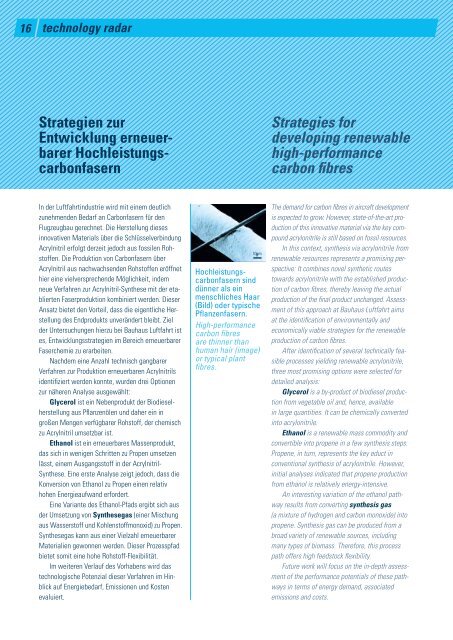Jahrbuch Bauhaus Luftfahrt 2015
Sie wollen auch ein ePaper? Erhöhen Sie die Reichweite Ihrer Titel.
YUMPU macht aus Druck-PDFs automatisch weboptimierte ePaper, die Google liebt.
16<br />
technology radar<br />
Strategies for<br />
developing renewable<br />
high-performance<br />
carbon fibres<br />
In der <strong>Luftfahrt</strong>industrie wird mit einem deutlich<br />
zunehmenden Bedarf an Carbonfasern für den<br />
Flugzeugbau gerechnet. Die Herstellung dieses<br />
innovativen Materials über die Schlüsselverbindung<br />
Acrylnitril erfolgt derzeit jedoch aus fossilen Rohstoffen.<br />
Die Produktion von Carbonfasern über<br />
Acrylnitril aus nachwachsenden Rohstoffen eröffnet<br />
hier eine vielversprechende Möglichkeit, indem<br />
neue Verfahren zur Acrylnitril-Synthese mit der etablierten<br />
Faserproduktion kombiniert werden. Dieser<br />
Ansatz bietet den Vorteil, dass die eigentliche Herstellung<br />
des Endprodukts unverändert bleibt. Ziel<br />
der Untersuchungen hierzu bei <strong>Bauhaus</strong> <strong>Luftfahrt</strong> ist<br />
es, Entwicklungsstrategien im Bereich erneuerbarer<br />
Faserchemie zu erarbeiten.<br />
Nachdem eine Anzahl technisch gangbarer<br />
Verfahren zur Produktion erneuerbaren Acrylnitrils<br />
identifiziert werden konnte, wurden drei Optionen<br />
zur näheren Analyse ausgewählt:<br />
Glycerol ist ein Nebenprodukt der Biodieselherstellung<br />
aus Pflanzenölen und daher ein in<br />
großen Mengen verfügbarer Rohstoff, der chemisch<br />
zu Acrylnitril umsetzbar ist.<br />
Ethanol ist ein erneuerbares Massenprodukt,<br />
das sich in wenigen Schritten zu Propen umsetzen<br />
lässt, einem Ausgangsstoff in der Acrylnitril-<br />
Synthese. Eine erste Analyse zeigt jedoch, dass die<br />
Konversion von Ethanol zu Propen einen relativ<br />
hohen Energieaufwand erfordert.<br />
Eine Variante des Ethanol-Pfads ergibt sich aus<br />
der Umsetzung von Synthesegas (einer Mischung<br />
aus Wasserstoff und Kohlenstoffmonoxid) zu Propen.<br />
Synthesegas kann aus einer Vielzahl erneuerbarer<br />
Materialien gewonnen werden. Dieser Prozesspfad<br />
bietet somit eine hohe Rohstoff-Flexibilität.<br />
Im weiteren Verlauf des Vorhabens wird das<br />
technologische Potenzial dieser Verfahren im Hinblick<br />
auf Energiebedarf, Emissionen und Kosten<br />
evaluiert.<br />
10 um<br />
Strategien zur<br />
Entwicklung erneuerbarer<br />
Hochleistungscarbonfasern<br />
Hochleistungscarbonfasern<br />
sind<br />
dünner als ein<br />
menschliches Haar<br />
(Bild) oder typische<br />
Pflanzenfasern.<br />
High-performance<br />
carbon fibres<br />
are thinner than<br />
human hair (image)<br />
or typical plant<br />
fibres.<br />
The demand for carbon fibres in aircraft development<br />
is expected to grow. However, state-of-the-art production<br />
of this innovative material via the key compound<br />
acrylonitrile is still based on fossil resources.<br />
In this context, synthesis via acrylonitrile from<br />
renewable resources represents a promising perspective:<br />
It combines novel synthetic routes<br />
towards acrylonitrile with the established production<br />
of carbon fibres, thereby leaving the actual<br />
production of the final product unchanged. Assessment<br />
of this approach at <strong>Bauhaus</strong> <strong>Luftfahrt</strong> aims<br />
at the identification of environmentally and<br />
economically viable strategies for the renewable<br />
production of carbon fibres.<br />
After identification of several technically feasible<br />
processes yielding renewable acrylonitrile,<br />
three most promising options were selected for<br />
detailed analysis:<br />
Glycerol is a by-product of biodiesel production<br />
from vegetable oil and, hence, available<br />
in large quantities. It can be chemically converted<br />
into acrylonitrile.<br />
Ethanol is a renewable mass commodity and<br />
convertible into propene in a few synthesis steps.<br />
Propene, in turn, represents the key educt in<br />
conventional synthesis of acrylonitrile. However,<br />
initial analyses indicated that propene production<br />
from ethanol is relatively energy-intensive.<br />
An interesting variation of the ethanol pathway<br />
results from converting synthesis gas<br />
(a mixture of hydrogen and carbon monoxide) into<br />
propene. Synthesis gas can be produced from a<br />
broad variety of renewable sources, including<br />
many types of biomass. Therefore, this process<br />
path offers high feedstock flexibility.<br />
Future work will focus on the in-depth assessment<br />
of the performance potentials of these pathways<br />
in terms of energy demand, associated<br />
emissions and costs.














